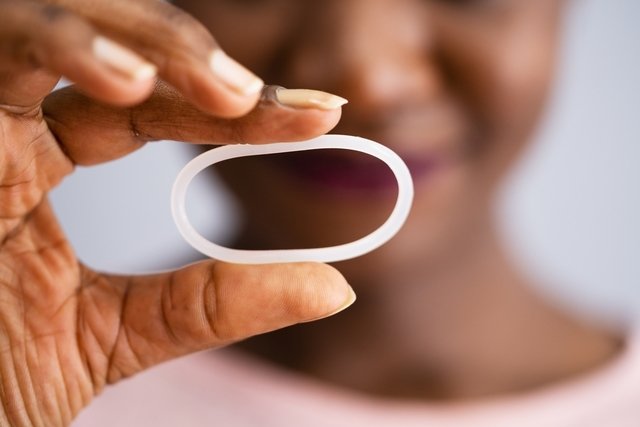The vaginal ring is a type of contraceptive method in the form of a ring measuring approximately 5 centimeters, which is made of flexible silicone and which is inserted into the vagina every month in order to prevent ovulation and pregnancy, through the gradual release of hormones. The contraceptive ring is very comfortable, as it is made of a flexible material that adapts to the contours of the region.
This method must be used for 3 consecutive weeks and, after that time, it must be removed, taking a break of 1 week, before putting in a new ring. When used correctly, this contraceptive method is more than 99% effective in protecting against unwanted pregnancy.
The vaginal ring can be found in pharmacies under the trade name Nuvaring, and should only be used if recommended by a gynecologist.

How it works
The vaginal ring is made from a type of silicone that contains synthetic female hormones, progestogens and estrogens. These two hormones are released over 3 weeks and act to inhibit ovulation, preventing fertilization and, consequently, a possible pregnancy.
After 3 weeks of using the ring, you must take a break of 1 week to allow your period to start before putting on the new ring.
How to put on the vaginal ring
The vaginal ring must be inserted into the vagina on the first day of menstruation. To do this, you must follow the following steps:
- Check the expiration date ring packaging;
- Wash hands before opening the packaging and holding the ring;
- Choose a comfortable positionsuch as standing with one leg higher and the foot resting, or lying down, for example;
- Hold the ring between the index finger and the thumb, squeezing it until it forms a shape similar to an “8”;
- Insert the ring gently into the vagina and push lightly with your index finger.
The exact location of the ring is not important for its function, so each woman should try to position it in the location that is most comfortable.
After 3 weeks of use, the ring can be removed by inserting the index finger into the vagina and gently pulling it out. Then, it must be placed in the packaging and thrown in the trash.
When to replace the ring
The ring needs to be removed after 3 weeks of continuous use, however, it should only be replaced after 1 week of rest. Therefore, it must be placed every 4 weeks.
A practical example is: if the ring is placed on a Saturday, around 9 pm, it must be removed 3 weeks later, that is also on a Saturday at 9 pm. The new ring must be placed exactly 1 week later, that is, next Saturday at 9 pm.
If more than 3 hours pass after the time to insert the new ring, it is recommended to use another contraceptive method, such as a condom, for 7 days, as the effect of the ring may be reduced.
Main advantages and disadvantages
The vaginal ring is one of several contraceptive methods available and, therefore, has advantages and disadvantages that must be evaluated by each woman when selecting a contraceptive:
Learn about other types of contraceptive methods and find out the advantages and disadvantages of each one.
What to do if the ring comes off
In some cases, the vaginal ring may unintentionally come out into the panties, for example. In these cases, the guidelines vary depending on the time the ring has been outside the vagina:
- Less than 3 hours: The ring should be washed with soap and water and then reapplied inside the vagina. For up to 3 hours, the effect of this method continues to protect against possible pregnancy and, therefore, it is not necessary to use another contraceptive method.
- More than 3 hours in the 1st and 2nd week of use: In these cases, the effect of the ring may be compromised and, therefore, in addition to washing and replacing the ring in the vagina, another contraceptive method must be used, such as a condom, for 7 days. If the ring comes off during the first week, and unprotected intimate intercourse has occurred, there is a risk of possible pregnancy.
- More than 3 hours in the 3rd week: In this case, the woman should throw the ring in the trash and then start using a new ring or take a 7-day break and insert a new ring afterwards, it is important to follow the gynecologist’s instructions.
If you forget to replace the ring and the break is longer than 7 days, it is recommended to put on the new ring as soon as you remember and start the 3 weeks of use from that day. It is also important to use another method of contraception for at least 7 days to avoid pregnancy. If unprotected intimate contact occurred during the break, there is a risk of pregnancy and a gynecologist should be consulted. Learn how to identify the first symptoms of pregnancy.
Possible side effects
Like any other hormone medicine, the ring has side effects that may occur in some women, such as:
- Belly pain and nausea;
- Frequent vaginal infections;
- Headache or migraine;
- Decreased sexual desire;
- Weight gain;
- Painful menstrual periods.
Furthermore, there is an increased risk of problems such as high blood pressure, urinary tract infections, fluid retention and clot formation.
Who should not use the ring
The contraceptive ring should not be used by women who have diseases that affect blood clotting, who are bedridden due to surgery, have suffered a heart attack or stroke, suffer from angina pectoris, have severe diabetes, high blood pressure, high cholesterol, some type of migraine, pancreatitis, liver disease, liver tumor, breast cancer, unexplained vaginal bleeding or allergy to ethinyl estradiol or etonogestrel.
Therefore, it is advisable to consult a gynecologist before using this contraceptive method, to assess the safety of its use.

Common questions about the vaginal ring
Below are the main questions related to the use of the vaginal ring:
1. Can I get pregnant using the ring?
The vaginal ring is a very reliable contraceptive method that prevents ovulation and, therefore, when used correctly, has a chance of pregnancy of less than 1%. Therefore, it is almost as effective as a condom.
However, if the ring is left out of the vagina for more than 3 hours or if it is not replaced correctly, it is possible that the woman may ovulate. Therefore, if you have unprotected sex in the 7 days before or after placing the ring, there is a possibility of becoming pregnant.
2. Can I have unprotected intimate contact?
The protective effect against possible pregnancy begins after 7 days of continuous use of the vaginal ring. Therefore, if you have sexual intercourse during the interval between removing and inserting the vaginal ring, pregnancy may occur. Therefore, women who do not intend to become pregnant should only have unprotected sex after this period.
However, if a woman does not have just one sexual partner, it is always recommended to also use a condom, as the ring does not protect against possible sexually transmitted infections.
3. Can I use the ring without pausing?
No, because after 3 weeks there is no release of hormones in sufficient quantity to inhibit ovulation, there is a risk of pregnancy if there is unprotected sexual intercourse. However, if you do not wish to have a period, it is possible, after 3 weeks, to insert a new vaginal ring, maintaining hormonal levels. However, it is important to consult your gynecologist so that more appropriate guidance can be given.
4. Can those who cannot take the pill use the ring?
Women who cannot take the pill due to the presence of hormones should not use the ring, as it also contains the same type of hormones as the pill.
However, if the problem is the emergence of intense side effects with the use of contraceptives, the ring can be a solution, as it has a different type of progesterone from most pills, reducing the risk of side effects such as swelling, increased weight loss, headache or swelling of the breasts.
5. Can I use the ring together with the pill?
Just like the contraceptive pill, the vaginal ring uses hormones to prevent ovulation and prevent unwanted pregnancy. Therefore, a woman who uses the ring should not also take the pill, as this will increase the concentration of hormones in the body, which can lead to more side effects.
6. Does using a vaginal ring make you gain weight?
Like any other hormone medicine, the ring can cause changes that lead to increased appetite and fluid retention throughout the body, favoring weight gain. The risk of these types of effects appearing is normally lower with the ring, and it can be used as a substitute for women who have gained weight with the pill, but who need to continue using hormones.
7. Can the ring cause bleeding outside of your period?
Due to the use of hormones, the ring has the risk of causing bleeding outside of the menstrual period, however, it is a change that does not cause any risk to the woman’s health.
However, if bleeding becomes more frequent or more abundant, it is recommended to inform your gynecologist to assess the need to change contraceptive methods.
8. Is the vaginal ring offered by the SUS?
The contraceptive ring is not one of the contraceptive methods offered by the SUS and, therefore, must be purchased at conventional pharmacies when recommended by the gynecologist.

Sign up for our newsletter and stay up to date with exclusive news
that can transform your routine!
Warning: Undefined array key "title" in /home/storelat/public_html/wp-content/plugins/link-whisper-premium/templates/frontend/related-posts.php on line 12
Warning: Undefined array key "title_tag" in /home/storelat/public_html/wp-content/plugins/link-whisper-premium/templates/frontend/related-posts.php on line 13




